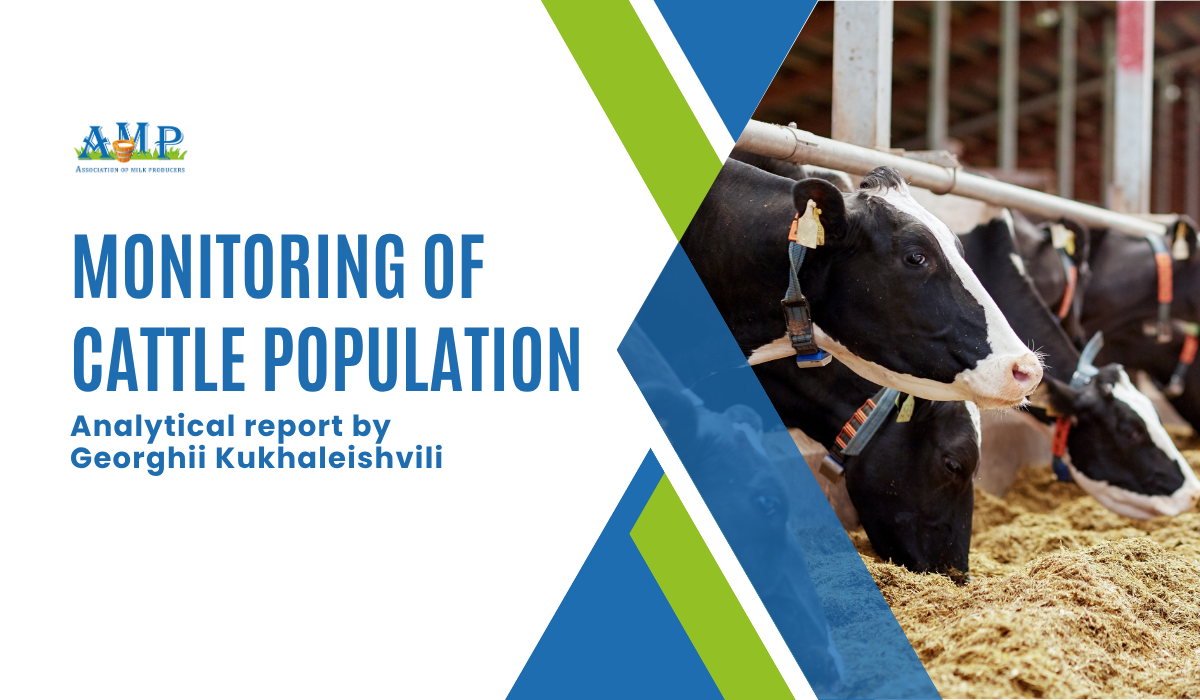As of June 1, 2025, the cattle population in Ukraine has decreased by 8% compared to last year, primarily due to a reduction in the number of animals in the household sector. At the same time, a slight increase in the number of cows has been recorded in the industrial sector. The increase in cow herd sizes is constrained by uncertainty in the dairy market and a decrease in raw milk purchase prices, reports Georghii Kukhaleishvili, an analyst at the Association of Milk Producers (AMP).
According to preliminary data from the Ministry of Agrarian Policy, as of June 1, 2025, Ukraine's household and industrial sectors collectively maintain 2,169.9 thousand head of cattle, including 1,149.4 thousand cows. Compared to May 1, 2025, the cattle population in Ukraine decreased by 10 thousand head (-0.5%), and the number of cows decreased by 3.9 thousand head (-0.3%). Compared to June 1, 2024, the cattle population decreased by 189 thousand head (-8%), including cows by 104 thousand head (-8%). Approximately 42% of the animals are kept by industrial enterprises, and 58% by household farms.
In the industrial sector, there are 918.6 thousand head of cattle, which is 3 thousand head less (-0.3%) than on May 1, 2025. The cow population stands at 382.3 thousand cows, a decrease of 100 head (-0.03%) over the last month. Over the past year, the cattle population at enterprises decreased by 1 thousand head (-0.1%), but the number of cows increased by 3.7 thousand head (+1%).
The household sector contains 1,251.3 thousand head of cattle, a decrease of 7 thousand head (-1%) compared to May 1, 2025. The number of cows in household farms as of June 1, 2025, was 767.1 thousand head, which is 4 thousand head less (-0.5%) than a month ago. Over the past year, the number of cattle in household farms decreased by 188 thousand head (-13%), and the number of cows decreased by 107 thousand head (-12%).
Georghii Kukhaleishvili notes that the reduction in cattle population is a long-standing problem in Ukraine due to the lack of an effective state program supporting dairy farming. The war has only worsened the situation. There are preconditions for the relocation of farms from Dnipropetrovsk and Sumy oblasts to other regions of Ukraine amid intensified Russian missile and bomb attacks on border and frontline settlements. Farmers will only be able to transport a portion of their herds, as most farms in Ukraine were built in the 1970s-80s and no longer meet the requirements for animal housing. The shortage of suitable premises for keeping cows creates prerequisites for further herd reduction.
In addition to the frontline regions, the cattle population in agricultural enterprises in Zakarpattia and Chernivtsi oblasts has decreased, which is likely related to their efforts to improve efficiency and sell unproductive cows. Market uncertainty and falling raw milk purchase prices do not contribute to an increase in cow herds in the industrial sector, and farmers are focused on reducing production costs.
Many farmers are not investing in increasing cow herds during the war and are experiencing a shortage of working capital. According to the study "Ukraine: The Impact of War on Agricultural Production Profitability," conducted by UCAB, the Ministry of Agrarian Policy, with the support of GFDRR, farmers' production costs are rising faster than finished product prices due to increasing feed costs, electricity costs, the devaluation of the hryvnia, and a decrease in the population's purchasing power.
The situation with foot-and-mouth disease in Hungary and Slovakia has been localized, which allowed for the lifting of most restrictions and the resumption of trade. No further spread of the disease is currently recorded, providing grounds for cautious optimism. However, biosecurity measures at dairy farms are of great importance for preventing the spread of the disease in Ukraine.
According to preliminary data from the Ministry of Agrarian Policy, the largest increase in the number of cows was recorded in agricultural enterprises in Lviv Oblast (+11%), Ternopil Oblast (+5%), Khmelnytskyi Oblast (+5%), Kyiv Oblast (+4%), and Volyn Oblast (+4%) compared to June 1 last year.
Regionally, approximately 55% of the total cattle population in all categories of farms is maintained in the following oblasts:
- Khmelnytskyi Oblast – 196.6 thousand head;
- Poltava Oblast – 177.4 thousand head;
- Vinnytsia Oblast – 174.7 thousand head;
- Odesa Oblast – 137.7 thousand head;
- Ternopil Oblast – 134.5 thousand head;
- Cherkasy Oblast – 125.4 thousand head;
- Chernihiv Oblast – 124.2 thousand head;
- Zhytomyr Oblast – 114.6 thousand head.
Press Service of the Association of Milk Producers
Follow us on Facebook
Related News


